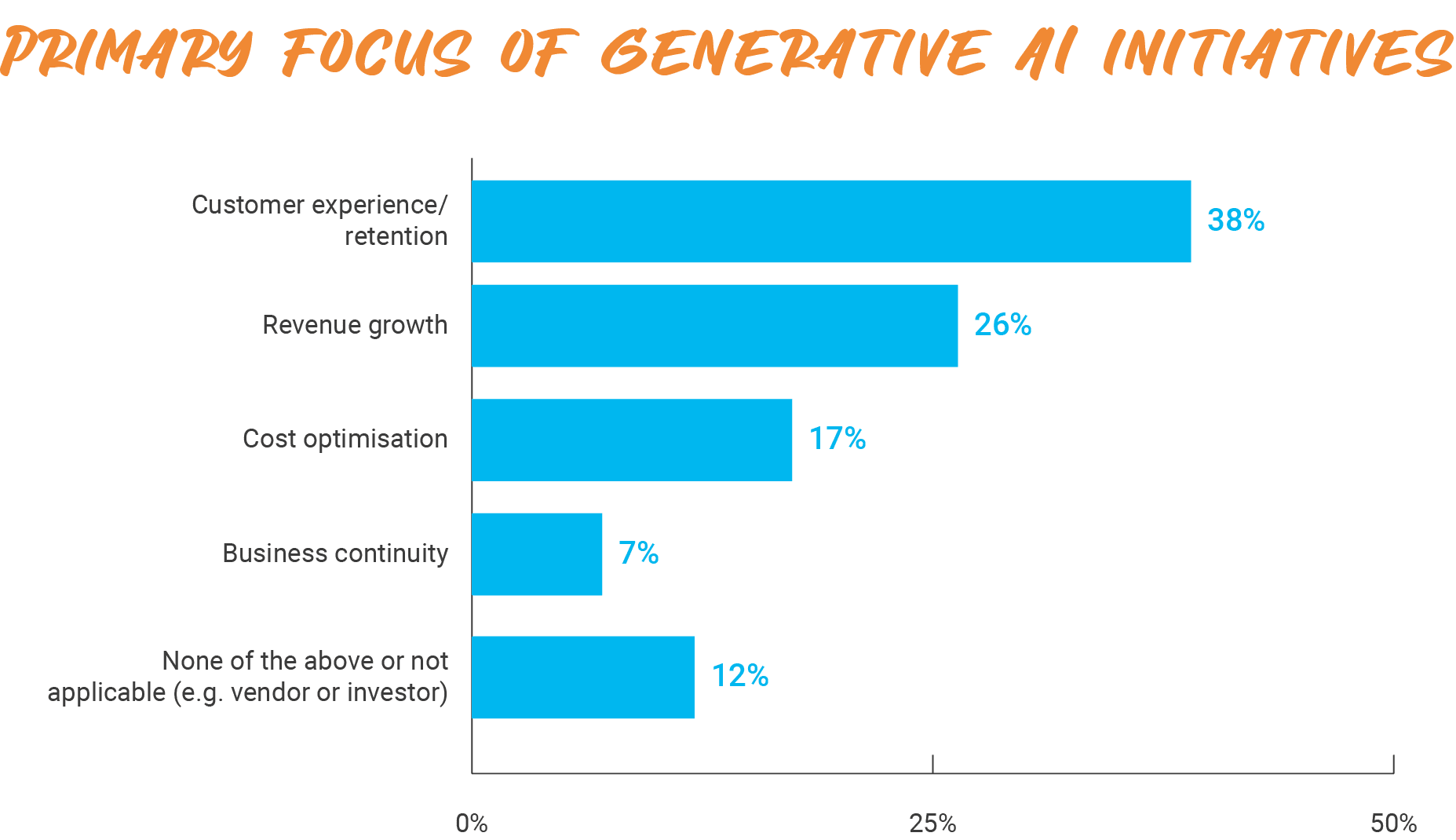- Blog
- Part 2 Generative AI special report: plan for long-term
Part 2 Generative AI special report: plan for long-term

Look no further than the blockchain experience of the past decade, which saw extraordinary hype about the technology’s potential1 before plateauing to more realistic expectations for some and falling to disillusionment for others2.
So we come to Generative AI and a year that has seen countless headlines about how solutions such as ChatGPT will shape the future of work3. In a recent podcast, McKinsey Technology Council chair Lareina Yee highlighted research that estimates 80% of jobs can incorporate Generative AI technology and capabilities into daily activities4 and many executives are now imploring their teams to develop proof of concept for any number of tasks across the customer experience realm.
For many, it must seem too good to be true and while there is indeed a lot to like about Generative AI, I have a clear message for business leaders salivating at the thought of all those proofs of concept – beware the sugar hit.
.png)
Source: Generative AI Market Size to Hit USD 110.8 Billion by 2030 (acumenresearchandconsulting.com)
Remember the big picture
There is undoubtedly immense transformative value to be had from the application of Generative AI. This is particularly so for its potential to improve workplace productivity, from lowering the barriers of entry to access specialised knowledge to outsourcing learning to the domains of the large language models.
However, if an organisation makes a misstep with technology in today’s world, it has the potential to be amplified like never before. Unleashing a still relatively unknown technology in the customer service space runs the risk of misinformation, inaccuracies and untold brand damage, which is why I believe it pays to take a moment to press pause in the current Generative AI hype cycle.
As a partner of many organisations that want to enhance their human capabilities with technological excellence, Probe CX is committed to rolling out solutions that are not only responsible and sustainable but also ensure our clients are fully aware of the various considerations they need to make when embarking on their Generative AI journey.
My concern is when organisations lose sight of that bigger picture and instead become addicted to short-term wins. For example, an executive may issue a directive to develop a proof of concept for the use of Generative AI in the contact centre and, upon seeing clear benefits, they experience that all-too-familiar high of success. But what happens when the high wears off? Like my children at a birthday party, they go in search of another sugar hit by commissioning another proof of concept … and then another … and then another.
That is what I see currently unfolding across many organisations in the Generative AI space. In search of their sugar high, they are rushing to find ways to incorporate the technology into their workplaces and, in the blink of an eye, suddenly find themselves with a dozen or more proofs of concept unfolding but no clear direction of where they are headed.

Source: Generative AI: What Is It, Tools, Models, Applications and Use Cases (gartner.com)
Scaled AI is the key
To use another metaphor, it is like building a house room by room. You put a room here, add a room there and then another couple before one day looking around and realising they are not connected and that is because you never had a blueprint to start with. That is my concern for many businesses amid the hype surrounding Generative AI. Too many proofs of concept. Not enough structure.
We are at the start of the AI-driven transformation era and as we come to understand the technology more, we will learn how to best scale it and adapt to it. Rather than seeking ‘sugar hits’, it is likely we will recognise that technology represents a greater opportunity to make a fundamental change to how we view the interplay between tasks, data and people. Although there is value in using it to provide smart insights automation or decision support, there may be far greater potential to harness it to create interconnected systems of decisions, automated and self-governed processes and, ultimately, a truly blended AI/Human workforce.
Where AI was once about discrete solutions, algorithms or models, there is a shift unfolding to full AI systems or, as I prefer to call it, scaled AI. It is going to be transformative and of incredibly high value and that requires business leaders to take a more considered approach than aimlessly rolling out multiple proofs of concept. Instead, they need to design an overarching blueprint for their Generative AI ambitions that adds structure to the way they want different algorithms and models to become part of their organisations.
Summary
We are asking many questions as we guide our clients on their Generative AI journeys. How does the technology fit into their offerings? How can it best be used to improve customer experience? How can we help implement it in a way that delivers sustained value? It is all well and good to enjoy three, six or even 20 sugar hits but the real benefits will unfold by developing and deploying an all-encompassing Generative AI strategy and scaling the technology so that it becomes an integral part of their operations.
If you missed part one of this Generative AI special report, read it here: evaluating the risk vs rewards
Coming up in part 3, the crucial role of people in the AI/Human workforce.
Robotic process automation (RPA) is proving to be a game-changer for businesses. From hyper-automation to low-code platforms and increased focus on security, discover the latest developments shaping the world of automation.
About the Author
Jon Stone is a seasoned digital and data leader with a strong record of leading large-scale transformations across multiple regions. With more than 20 years of experience in consulting and technology firms, he is passionate about collaborating with clients to deliver innovative digital and data solutions that enhance CX and optimise core processes.
Reference:
[1] Blockchain: Hype, Reality and the Public Good (govtech.com)
[2] Blockchain & Crypto Hype Cycle: Where We’re at and What’s Coming Next | by Anthony Back | The Blockchain Review by Intrepid | Medium
[3] How ChatGPT and Generative AI Will Shape the Future of Work | Stanford Online
[4] The impact of generative AI on human resources | McKinsey


_future%20of%20work.jpg)